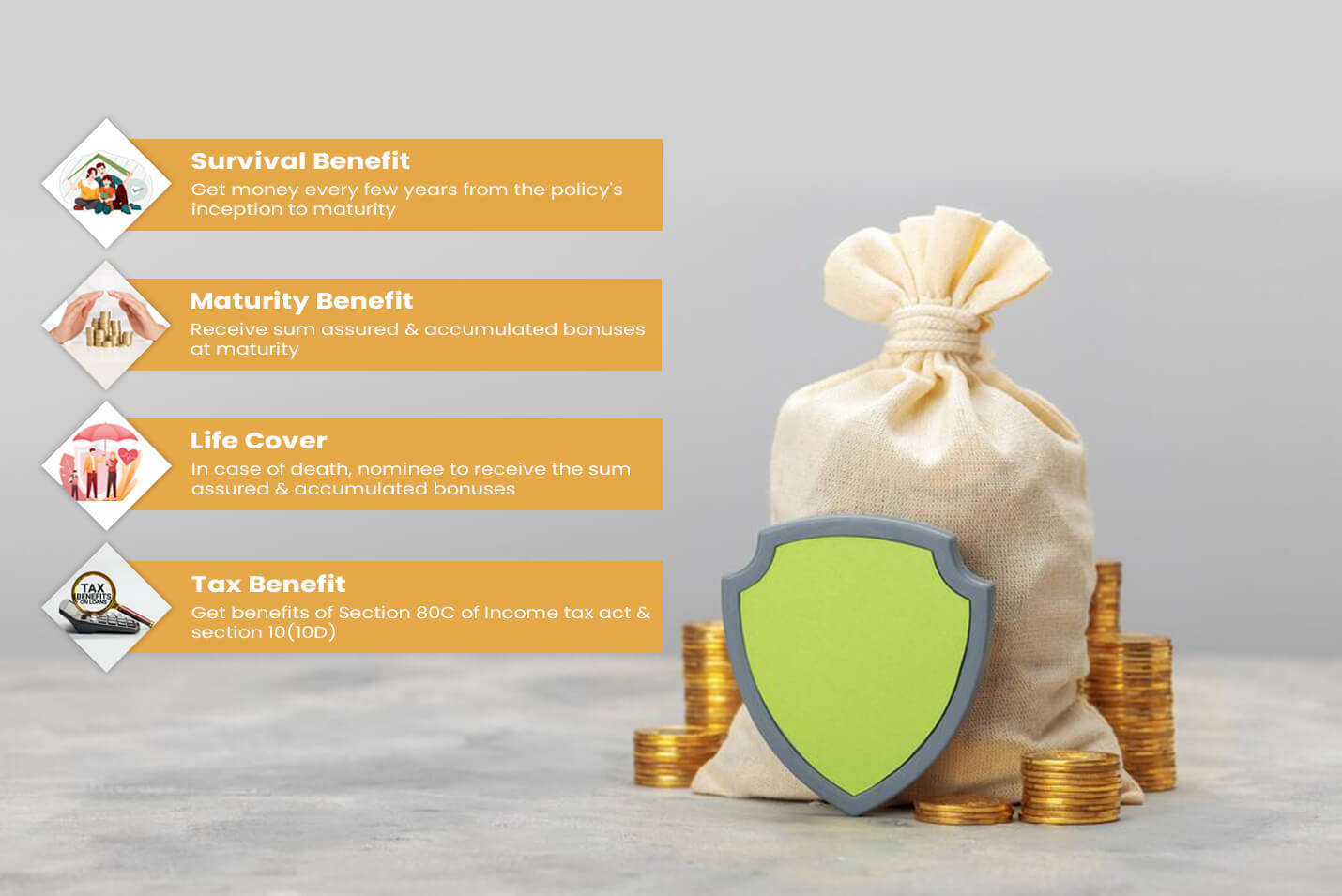The money return policy, sometimes referred to as the child money back plan, is a type of life insurance that provides maturity or survival rewards at the conclusion of the policy's term as well as life insurance coverage during that time. It is a life insurance policy that doubles as an investment, usually bought for kids.
*Disclaimer: A 30-year-old healthy male will get a lump sum payment of Rs. 28,06,000 from the insuranceliakya Life Smart Wealth Plan, which is a non-linked, non-participating individual life insurance savings plan, at the conclusion of 20 years.

A child money back plan is a conventional money back plan that uses survival incentives to meet the needs and requirements of growing children. Educational requirements, studying abroad, marriage, and other factors can differ from one child to the next
In basic terms, it is a combination of insurance and investment package that will assist in securing the child's promising future. This participating plan is also eligible for the incentive based on the plan's results.

In the case of the life insured's death, a standard insurance plan pays out a lump sum amount to the nominee of the policy. This is known as the death benefit of life insurance. On the other hand, a money back policy is a form of life insurance policy that allows the insured to receive a portion of the sum assured at regular intervals rather than a lump sum at the end of the policy period. As a result, a money back insurance policy is an endowment scheme with certain liquidity.
The amount that is received as payouts with it is known as the ‘Survival Benefits’. These are compensated over the policy term, and the remaining sum assured is paid at maturity, along with any vested incentives.

Here are some reasons that make money back policy suitable for you:
Let’s take a look at some valuable benefits of a money back policy:

Over the course of the policy, money is paid to the policyholder every few years. The payment begins within a few years of the policy's inception and lasts until the policy's maturity.
Consider this scenario: Akash has chosen a money back policy with a sum assured of Rs. 5 lakhs over a 20-year period. He will have to pay a 20-year premium and receive a portion of the sum assured at regular intervals.
Depending on the policy terms, he may receive 15% of the sum assured after the 5th, 10th, and 15th years of the policy, as a survival benefit, this is 15 X 3 = 45 % of the sum assured. He will also receive the remaining 55% of the amount guaranteed, plus any bonus, at maturity.
In the event of an unfortunate incident, the policy nominee will receive the death benefit. This includes the sum assured as well as any bonuses accumulated on the money back policy. Notably, this does not include the survival bonus, which is only paid out to the insured while they are still alive.
The insured individual receives the maturity benefit when the money back plan matures, and it consists of:
Section 80C of the IT Act allows you to deduct up to Rs. 1,50,000 in life insurance premiums from your taxable income per year. In addition, Section 10(10)D exempts the maturity benefit of the money back policy from taxation.
Before moving ahead with your purchase of a money back policy, whether it is a child money back plan or any other type of policy, you must be aware of the following features:

Money back plans mean that money is returned to the life insured as a survival benefit after a set period. When the policyholder survives the policy term, the money back is guaranteed. In the event of the policyholder's death, the nominee receives the amount guaranteed as well as any accumulated bonuses, if any. This is also applicable to child money back plans as well.
Money back policy ensures that the insured will earn returns or the amount promised every few years. Thus, the survival value is accumulated every few years and provides policyholders with a second source of income.
These funds may be used to take a vacation, save for an unexpected occurrence, save for a down payment on a house or apartment, or pay off the children's school or tuition fees. As a result, money back policies have an advantage over other types of life insurance on the market.
Most insurance providers sell optional add-on riders that the insured can ‘add-on' to their money-back policy, as the name implies. These riders may be related to medical conditions like life-threatening illnesses, personal accidents, or term riders.
The Money Back policy even contributes to the income of the insured by way of a bonus. Each year, the incentive is calculated as a percentage of the sum assured by the insurance provider, and accumulated. When the policy matures or if the policyholder passes away, the accumulated bonus is added to the total payout due.
Let’s refer to this scenario to better understand money back plans:
For every 5 years of the money back plan, the plan guarantees survival benefits of 25% of the sum assured. At the end of the term, 25% of the assured sum is payable, plus any accumulated bonuses.
Hence, Preeti receives Rs. 2.5 lakhs after a duration of 5 years, throughout the policy term, i.e. in the fifth, tenth, fifteenth, and twentieth policy years. Thus, Preeti has already earned Rs.10 lakhs by the 20th policy year.
She would be paid Rs. 2 lakhs, plus additional incentives, upon the maturity of the plan, and the plan would be terminated. In case of an unfortunate event, the nominee will receive Rs.10 lakhs in addition to the bonus, despite the fact that she has already earned Rs.6 lakhs in Survival Benefits.
Today, you will find a variety of money back plans in India. In addition, various life insurance companies provide these policies with a varying set of features and benefits to suit diverse financial profiles.
So, if you are wondering how to choose a money back policy that is best for your investment purposes, consider the following factors:
These are some basic questions you must ask yourself to make a well-informed decision. Apart from this, individuals should consider the policy tenure when selecting a money back policy. Generally, most money back plans come with an average policy period of 20 years.
Since money back policies pay a survival benefit to policyholders, prospective policyholders should find out the percentage of the sum assured which would be paid out in instalments. The amount should be sufficient to cover any expenditures that the policyholder will incur.
| Fixed Deposit | Money Back Plans | |
|---|---|---|
| Policy Term | Fixed deposits can be used for both long-term and short-term investments, with terms varying from one to five years. | The money back policy, on the other hand, provides life insurance as well as premium back options for a minimum policy term of 10 years, which can be extended to 30 years or more. |
| Investment | With a minimum investment of INR 1,000, you may begin investing in fixed deposits. On the other hand, there are no limits on the maximum investment. | In the case of money back plans, the policy premium varies from plan to plan and is calculated by a variety of factors such as the policyholder's age, the tenure chosen, and so on. |
| Returns | Fixed Deposits have a guaranteed return on investment. You may also take interest on your fixed deposit weekly, quarterly, or at the end of the year. | Likewise, money back plans have defined returns that are stated upfront. |
| Withdrawal | With fixed deposits, you have the option of partial withdrawal. Breaking an FD account before the maturity period ends, on the other hand, affects the interest rate of the fund and results in a low return on investment (ROI). | Premature withdrawals are also permitted after 2 years of policy tenure in a money back policy. Your returns, however, may be relatively smaller. |
| Options for Pay-out | With fixed deposits, you can take the payout amount as a lump sum at the end of the policy term. | Whereas a money back policy offers the corpus in the form of long-term annual/monthly instalments. You may also take the whole corpus as a lump sum payment. |
| Tax Benefits | Typically, fixed deposits do not have any tax benefits. There are, however, tax-saving fixed deposits that you can invest in for a period of five years and receive tax benefits under section 80C. | On the other hand, under sections 80C and 10(10D) of the Income Tax Act 1961, you will receive a tax benefit on the premiums charged and the maturity proceeds from a life insurance policy. |
Before purchasing a money back policy, one must meet the entry age requirements stated in the policy wordings. The policy cannot be extended beyond the maximum age permitted under the money back plan. It will also be helpful to check the premium payment mode and the term for the money back policy.
Additionally, these are the documents you will require to buy a money back policy:
Aadhaar card, Voter ID card, passport, driving license, and other forms of identification may be used to prove your age.
Before purchasing a money back policy, one must meet the entry age requirements stated in the policy wordings. The policy cannot be extended beyond the maximum age permitted under the money back plan. It will also be helpful to check the premium payment mode and the term for the money back policy.
Additionally, these are the documents you will require to buy a money back policy:
Aadhaar card, Voter ID card, passport, driving license, and other forms of identification may be used to prove your age.
As mentioned below, the money back policy has a range of unique features that set it apart from other life insurance products:
For an additional premium, the insured can easily add several riders to their money back policy. Generally, the riders provided include:
A money back policy is much less risky than investing in a mutual fund. It can be a favourable situation for the investor because it is a tax-saving investment with assured returns over the period, as well as providing comprehensive life insurance coverage.
You can reduce your tax obligation by choosing a money back plan. The assured returns plans produce tax-free returns because they qualify for the EEE exemption under Section 80C and Section 10 (10D) of the Income Tax Act.
Before buying a money-back policy, you must be of the specified age, as mentioned in the policy wording. The policy scheme cannot be expanded past the money-back plan's maximum age limit.
Due to non-payment of premiums, your policy benefits may be reduced, while the contract remains valid.
Premiums for money back plans are usually charged annually or monthly, but you may also be given the option of paying semi-annually (twice a year) or quarterly (four times a year).
Section 10(10D) of the Income Tax Act of 1961 exempts money earned from money back policy from taxation.
It is not possible to transfer the money back policy.
The inclusion of policy revival is needed because it gives the insured individual the opportunity to renew the policy and continue coverage under the plan. The lapsed policy may be renewed at any time within 5 years of the unpaid premium date.
The policyholder can surrender the policy at any time. It is the opportunity to withdraw from a life insurance policy until it matures, in which case the policyholder will receive the Surrender Value. The policy acquires a Guaranteed Surrender value after two full years’ premium payment
There is no single money back policy that will be suitable for each person’s requirement. There is a range of personal factors that must be considered to buy the best money back policy for you and your loved ones, such as your financial objectives, income source, budget, etc.

Do not hesitate to say Hello